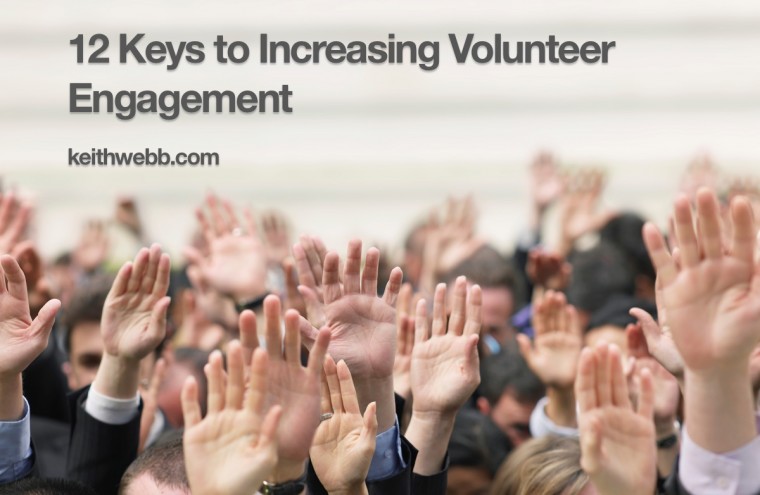Volunteer participation is the engine that runs our society. It’s not just churches and nonprofits who need volunteers, it’s every professional association, school, fire department, library, sports team, hobby group, and community pea patch. Everyone needs to increase both the number of volunteers and their engagement. Here are 12 keys to help you do that.

I recently wrapped up my time as president of the International Coach Federation Washington State Chapter, a professional coaching association. When I joined the board 4 years ago, board members did much of the work of planning events and keeping the association moving forward. This resulted in a lot of work from a few people.
Recruiting new board members was difficult because people saw how much time we put in and our high stress levels!
We implemented changes and formed teams around all our chapter’s functions. The teams were able to produce far better events – larger and more impact – than what our over-worked board could do on its own. Now the chapter has four times the number of people volunteering.
Here’s what we did (and should have done sooner) to increase volunteer engagement:
12 Keys to Increasing Volunteer Engagement
- Create a clear pathway. What is needed? What would the responsibilities be? Why does this matter? How much time will it take? Who can I talk to learn more? How do I get started? The other 11 Keys go into greater detail.
- Start with benefits to the community. Why is this necessary? How will it benefit the cause? Demonstrate what the positive results will be.
- Answer, “What’s in it for me?” How will volunteering help our careers or lives. Appeal to the volunteer’s desire to connect, further their career, and grow.
- Invite personally. Why me? Your answer tells me if you understand me and what my interests and abilities are or if you’re just looking for a warm body.
- Ask for big-picture planning help. If the event is your idea we might give a few hours. If we’ve in at the formation stage and have contributed our ideas we’ll give a lot of time.
- Communicate effectively. Don’t sound desperate. Desperation can back-fire by being interpreted as no one else is interested, therefore the burden will fall on us if we volunteer. Share examples of other volunteers that people can model after. This serves two purposes, by also publicly acknowledging a volunteer.
- Fix a clear time commitment. Not long term. Avoid hints of time-creep. Stories of last minute, round-the-clock work to pull off a project deadline makes people skeptical of your time estimates.
- Offer meaning through service. Focus on why this matters. We all want to be productive and feel our work matters, so tell us why it matters. This is the #1 consideration for many people.
- Ask for skilled work, not grunt work. Many won’t volunteer to stuff envelops, but will take charge of planning an event or write an article if these things match their passions and gifting.
- Show gratitude in multiple ways. Personally thank them. Have someone in leadership send a note. Be public. Give a small gift at a meeting or event. Mention them in a newsletter. Share an inspiring story of results and name-drop who was involved.
- Foster community among volunteers. Many people are looking to connect with others while doing meaningful work. Don’t make it all work and no play. Personal connection to others bonds them to the organization.
- Coach them to success. Train and coach volunteers where they need it. Developing volunteers helps them and your cause.
This list isn’t for someone else to do. It’s for you to do. With your kids at home. With your employees at work. In your community or club. If you treat people in these ways they will be motivated to give their best.
Volunteer engagement will increase if you engage people in inviting ways that connect their passions, gifting, and add meaning to their lives.
Question: What helps you to say “yes” to volunteering? You can leave a comment by clicking here.


Seems like the personal invitation is the most effective. When we have used broad email appeals very few people respond. A personal phone call or a brief coffee has always brought greater results.
Helpful approach Charles. I’ve found the same for fundraising, recruiting board members, and forming a church home group.